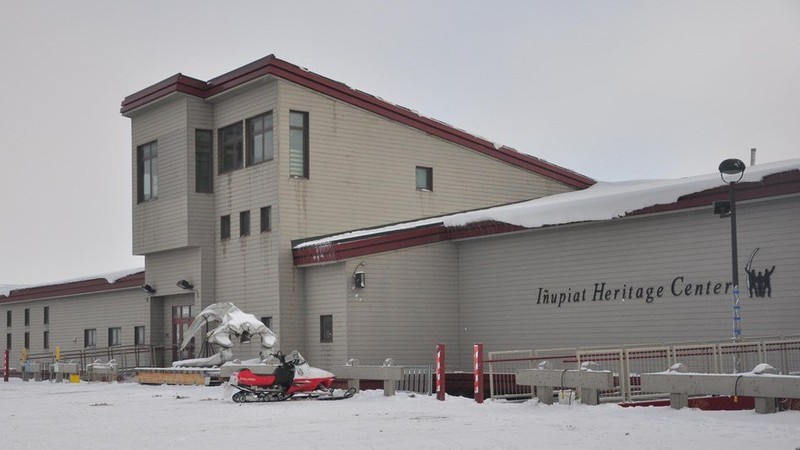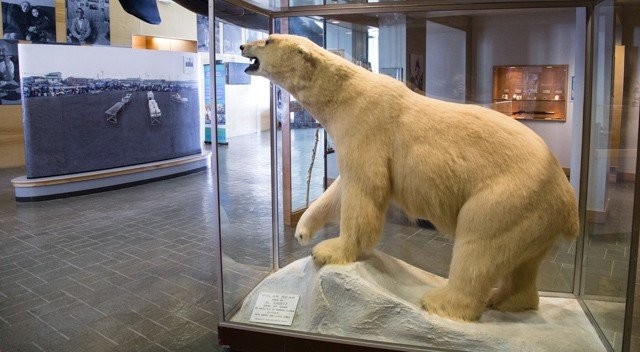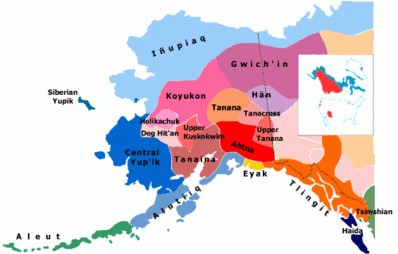Iñupiat Heritage Center
Introduction
Text-to-speech Audio
Images
Front of the Heritage Center. Credit: National Park Service

Researchers Jesse Dodson, Taylor Hardwick, and Mythianne Shelton visited the center to learn more about the Inupiat people, their way of life and their history. Credit: Radford University

A polar bear on display at the Heritage Center. Credit: Radford University

Inupiaq language, with dialectical differences, is spoken from Norton Sound in Alaska to Greenland. They are represented on this map in light blue. Credit: Alaska Native Language Center - University of Alaska, Fairbanks

Backstory and Context
Text-to-speech Audio
In the late 19th and 20th centuries, over 2,000 whaling voyages set out from New Bedford, Massachusetts, bound for the bowhead whaling grounds off Alaska's arctic coast. The voyage of over 20,000 miles took the whalers to the Azore Islands off the coast of Africa, around Cape Horn and the southernmost tip of South America, to the Hawaiian Islands and finally, to the Bering Sea and Arctic Ocean. Many Alaska Natives, particularly Iñupiat Eskimo people, participated in commercial whaling. In addition to crewing on the ships they hunted for food for the whalers, provided warm fur clothing, and sheltered many crews that were shipwrecked on the Alaska coast.
Yupik and Iñupiat people of northern Alaska and the Bering Straits had been whaling for a thousand years when Yankee whalers arrived in the arctic during the late nineteenth century. More than 2000 commercial whaling voyages sailed from New Bedford—the capital of the global whaling industry—into arctic waters during the following decades. Many Alaska Natives played a direct role in the commercial whaling enterprise and everyone experienced its effects. They joined Yankee whaling crews, supplied local, wild food to the whalers, shared traditional clothing designs adapted to arctic conditions, and sheltered many shipwrecked whaling crews.
The Iñupiat Heritage Center was dedicated in February 1999 and houses exhibits, artifact collections, library, gift shop, and a traditional room where people can demonstrate and teach traditional crafts in Elders-in-Residence and Artists-in-Residence programs. It was also designated an affiliated area of New Bedford Whaling National Historical Park in New Bedford, Massachusetts to ensure that the contributions of Alaska Natives to the history of whaling is recognized.
As an affiliated National Park, the North Slope Borough owns and manages the Iñupiat Heritage Center. The center is one of the many associated partners that engage in spreading the story of commercial whaling in the United State. Different Park partners conduct but collaborate in an array of educational and informative programs and activities. Park partners operate independently but collaborate in a variety of educational and interpretive programs.
The Iñupiat Heritage Center recounts the story of the Iñupiat people who then struggled for thousands of years in one of the harshest climates and conditions on Earth.
Sources
About the Center. National Park Service. Accessed March 31, 2018. https://www.nps.gov/inup/aboutthecenter.htm.
Whaling Voyages. National Park Service. Accessed March 31, 2018. https://www.nps.gov/inup/details.htm.
